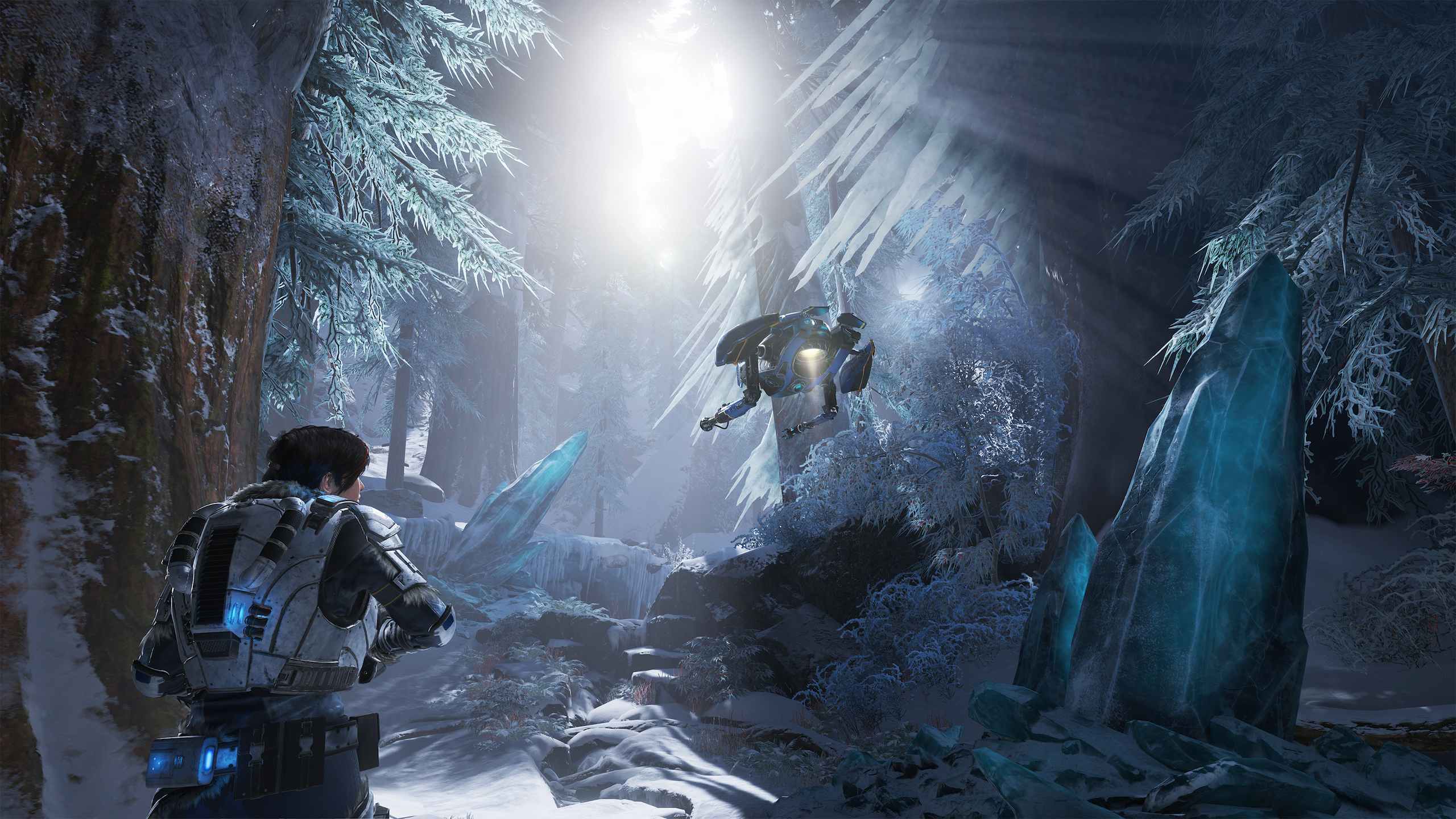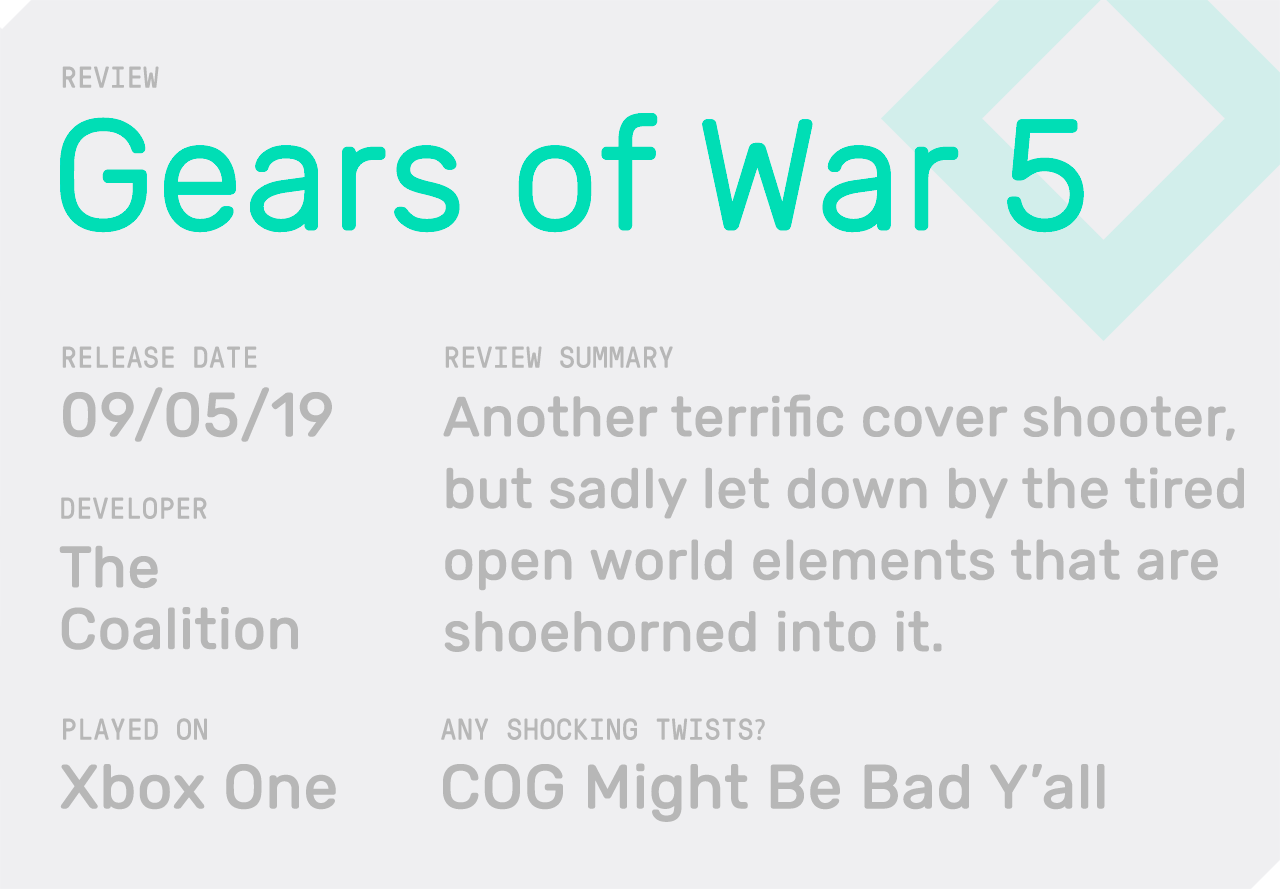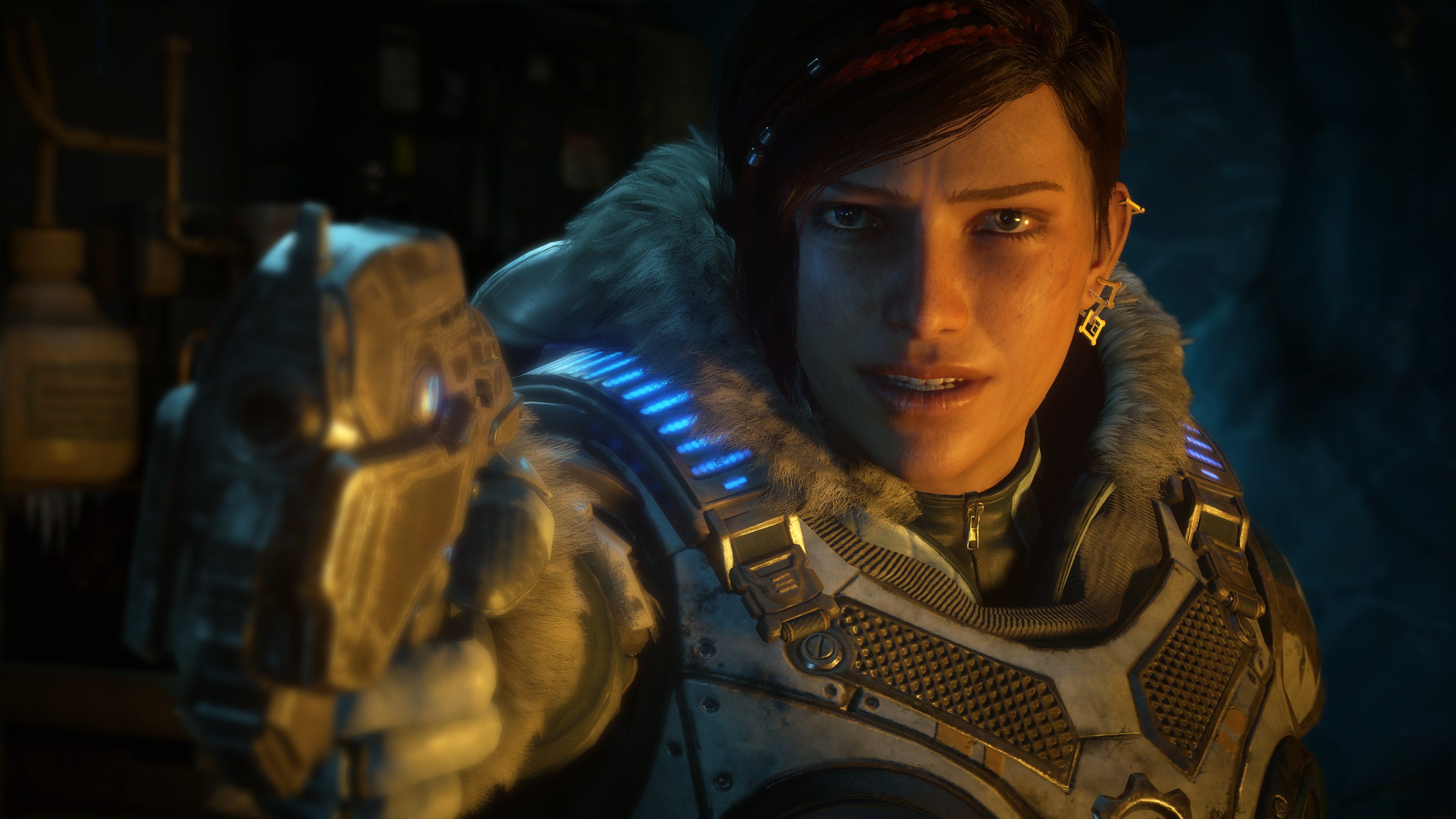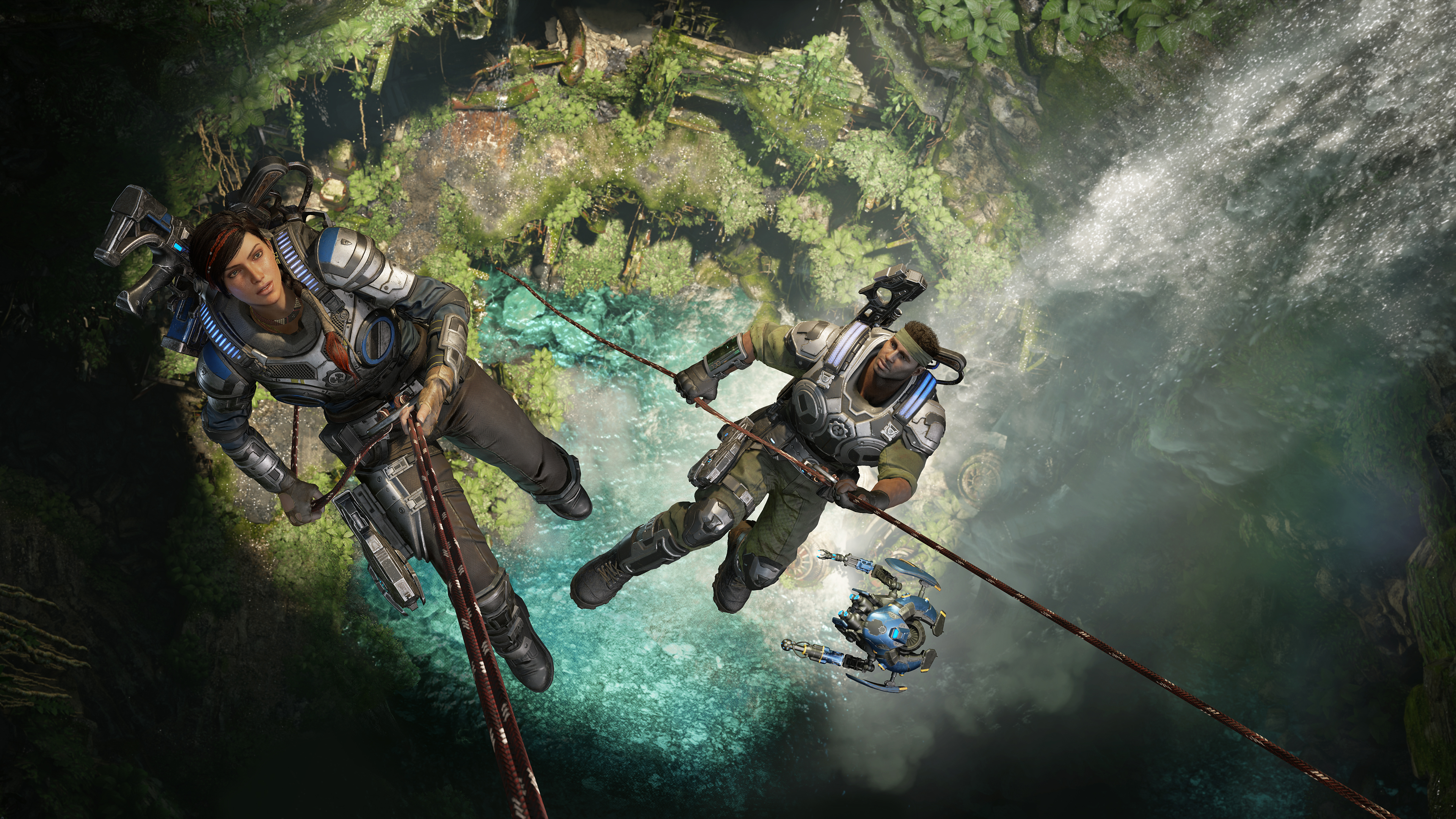‘Gears 5’ Is Playing Catch-Up With Ideas That Are Already Outdated
Credit to Author: Cameron Kunzelman| Date: Wed, 04 Sep 2019 13:02:27 +0000
Gears 5, the sixth game in the Gears of War franchise, is full of familiarity. It’s roughly the same as 2007’s original Gears of War: you hide behind cover, you shoot things from behind that cover, and you respond to the world in front of you with the maximum number of explosions and violence that you can. Following on from the plot of Gears of War 4, this game’s protagonists JD Fenix and Kait are both part of the “new generation” of soldiers in the eternal war of all against all. They do the same thing that we did back in 2007, and likewise their enemy the Swarm does all of the things that the Locust did way back then. This, I think, is all done admirably. The things feel like they’re supposed to feel, and each little interaction provides the right amount of oomph to keep me engaged through a firefight. It’s where Gears 5 tries to change things up that it stumbles.
To cut to the meat of it: there are no major gameplay iterations in Gears 5 when it comes to the basic core loop of combat. You enter into an area and clear it of enemies in a kind of rolling assault, or you take a zone and defeat waves of enemies. There’s an active reload button to make your bullets punchier, there’s a wide array of weapons to use, and your companions will hoot and holler about it the entire time.
This feels as good as it has across all the entries of the series, and if you’ve made peace with the politics, the shape of masculinity and statecraft and shooting violence that is part and parcel of this world, then you will enjoy what this is. And I don’t say that in a world-weary way. These games have sharpened their gameplay to a fine edge. They have not changed their basic political claims in more than a decade. These are some of the most dependable games as far as expectation and delivery that you can look for in games, and on that level I had a great time doing the things that Gears does best. If you are reading this review with concern about whether this is still a Gears game then, well, there you go.

What I think is interesting about Gears 5 is where it diverges from the picture we’ve had of this franchise for over a decade. This game has four acts. In the first, you play as JD Fenix, and you’re mostly doing the run-and-gun heroics and operating that we associate with these games across the board. You’re doing stuff with other super soldier Gears, and you’re defending the Coalition of Ordered Governments. In the remaining acts, you take control of Kait, a former member of the non-Coalition Outsiders, whose perspective on statecraft and policing and action hero stuff is a little more complicated than JD’s.
The result of this switch in character perspectives is that Gears 5 feels like a bridge between two worlds. There’s the world before, the one of the JD Fenix and his father Marcus, and then this new world of Kait and the kind of gameplay that she brings with her. As I said, the combat feels familiar, but there’s a suite of new ways of interacting with the Gears world that feels a little out of place for the franchise.
The second and third acts of Gears 5 have extensive limited open world segments. Kait and her various combat partners load up on a wind sailing skiff and take to both snowy wilds and desert dunes. You’re given a small map to scoot around in, and the main quest can go on pause for a bit while you hunt down side locations or help out the needy. You get to hear some vulnerable dialogue from the Gears, whether it’s asking if each other are ok or simply shaking their heads in surprise about what happened back there. It’s down time with some purpose behind it, all linked together by the short fights that link everything in the Gears of War games together.

On one hand, the open word segments obviously work for what they’re intending to do. They give you more opportunities to do more stuff that Gears do. But I can’t be the only person who thinks that the great strength of these games is that they don’t overstay their welcome. Playing through the original Gears of War for the Xbox 360 a few weeks back, I was astonished by how much the success of that game had to do with its pacing: you have an objective, you either complete it or it gets beefed up somehow, and you need to immediately pivot to some other goal. There’s always an objective right in front of you, and it needs to be accomplished now, no matter what gets in your way. That’s the emotion that fuels the chainsaw gun. It’s pure adrenaline, and it works through all the games in that original trilogy.
The open world segments of Gears 5 really throw a wrench in the works of narrative pacing, even if you beeline from objective to objective. There is the possibility of doing sidequest events, and that option just grinds the game to a screeching halt. The power fantasy that Gears of War revolves around, which is centered entirely on powerful figures heroically doing what no one else can on a tight timeline, just dwindles down into a leisurely desert romps. And I like the romps, generally, but I can’t pretend like something doesn’t get dropped in their pursuit.
This precise struggle with the past and the future is thematized in Gears 5 itself. Act 2 takes the familiar protagonist unit Delta Squad back to New Hope, a facility that revealed the human trial experiments that led to the creation of the Locust, which we last saw in Gears of War 2. In that game, New Hope largely works as a narrative development location. You thought you knew this world and your job, but the rabbit hole goes deep, and maybe the Coalition of Ordered Governments aren’t as good as we thought they were. In Gears 5, we literally go even deeper into the facility, learning even more about how bad the past was and who was to blame for it.

All of that is plot specifics, but this second experience of New Hope operates via revision of the first time we were here. The story is more serious and personal. The lore, and the violence against characters that fuels that lore, is more extensive than we ever knew. The Sires we fought a generation ago are only a part of the threat of this place. All of this feels like a plea from Gears 5 to the player: if we ground all of this expansion in what you’re familiar with, will you let us have it? Can we have characters who have an emotional range larger than chest bumps and hoo-ah? Can we tell a story of geopolitics and psychic connections and loss and generational trauma without losing our cover shooting powers?
I’m more than willing to say yes, but I can’t help but note that this revision, with its open world and increased narrative emotional complexity, comes at a cost of what could have happened instead. Gears 5 feels rough. The major mid-game boss fight at the end of Act 2 is frustrating and a slog. Act 3 is a long, boring series of fetch quests that felt like they took longer than the rest of the game combined, and it was packaged within a setup that the game kept telling me was extremely important even though I couldn’t understand why it was important. And the only real change in Gears 5, the ability to “use” your robot companion Jack to shock or stun or mind control enemies, is functionally just the implementation of biotic abilities from Mass Effect 2. It adds nothing significant. Messing with the formula delivers surface novelty and little else.
I’d be remiss if I didn’t mention that this game has a narrative choice in it. This, too, is an interesting revision, but it feels about as arbitrary as choosing to take the left or right path in a level in the original Gears of War. The context for the choice doesn’t make any sense, the character who forces you to have it seemingly appears out of nowhere, and the weighty gravity of it was wholly lost on me because it was such an easy one to make.
Gears 5 obviously feels that it needs to take risks to grow, but a single binary narrative choice, a limited open world, and a robot pal is not that. These are risks, sure, but they’re risks from 2013. In 2019, it simply makes Gears 5 look like a game that is desperately trying to play catchup in a race I don’t think it needs to be in. It makes the game feel unconfident, which is not something I’ve ever associated with this, the most overconfident game franchise in history.

I would trade all of these revisions and “updates” for 30 more minutes of context for the Outsider village you visit. Give me more of Kait’s Uncle, and let me see what the lives of people beyond the focus of the COG looks like. Let the characters speak more, not just as we skiff across the dunes, but in the context of the rockets they’re assembling or the weapons they’re using. Give me two or three optional NPC quest givers that really flesh out a deeper, more complicated story.
I think that there’s room to grow in the Gears of War franchise, and it’s very clear from playing Gears 5 that the developers feel the same way. The way that they have chosen to tackle this growth doesn’t feel like it is an experiment from within the Gears tradition, but instead it feels like several popular game ideas stapled onto the chassis of a Gears game. From the perspective of my enjoyment of this franchise, Gears needs depth instead of breadth. It needs iteration that takes us further into this model, not something that disperses us into open worlds and constant evocation of character emotions.
Don’t get me wrong. Gears 5 is fine. It has all the combat encounters and explosions you could want. But after playing through the whole thing, I can see the seams produced by trying to stretch this world and characters beyond what their core capacities, and the strain threatens to tear the whole franchise apart.
This article originally appeared on VICE US.